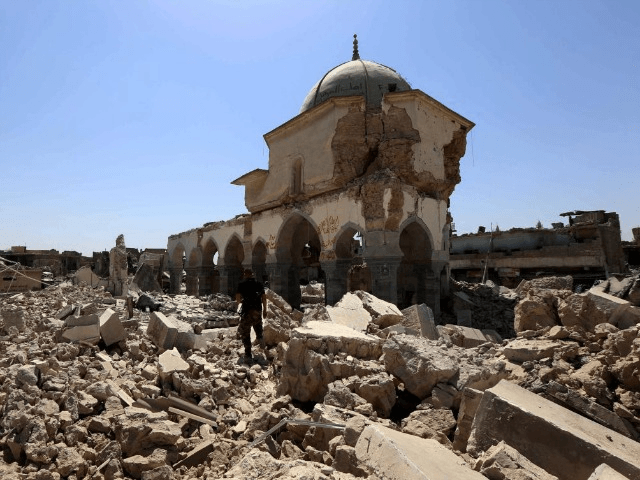According to a new report from the University of Maryland, the Islamic State is still the world’s deadliest militant organization, perpetrating 1,400 attacks and killing over 7,000 people in 2016. This represented a hefty 20 percent increase over 2015, even though ISIS suffered crushing defeats in Syria and Iraq.
Reuters notes the Islamic State’s territorial control peaked in August of 2014, but its calls for attacks by individuals and small groups increased as it lost ground, and it has forged alliances with violent militant groups in Bangladesh, Yemen, Libya, Afghanistan, and the Philippines.
Also noteworthy is the effort ISIS invests in teaching followers across the Western world how to perpetrate terrorist attacks, using such educational methods as how-to guides published in magazines and websites.
The Washington Post points out that ISIS published an illustrated article on how to carry out terrorist attacks with trucks and vans in its magazine Rumiyah, just a few weeks before such an attack was carried out in Barcelona.
“In the weeks preceding the Barcelona attack, the terrorist group issued at least a dozen new videos or online articles a day, most of them aimed at rallying supporters or encouraging sympathizers to kill and maim in its name. Many of the recent postings have explicitly urged followers to turn trucks and vans into weapons of terror,” the Post reports.
A post on a pro-ISIS channel of the encrypted messaging service Telegram urged jihadis to use the Barcelona attack as a model for their own atrocities, saying, “No need to travel the world. Just pick the main city. Find a hub spot for tourists. Choose you[r] weapon.”
The Post quotes analysts who say the Islamic State’s online presence remains dismayingly robust, despite a massive loss of infrastructure due to its defeats in cities like Mosul and Fallujah.
Production studios have been destroyed, computers have been seized, and Islamic State technicians have been neutralized. Coupled with active campaigns by major social media providers to eliminate ISIS pages, the social media footprint of the terror state has been chopped in half, but the half that remains is still extremely prolific.
The Post cites an analysis from the International Center for Counter-Terrorism at the Hague which concludes Islamic State leaders prepared for their battlefield defeats by shifting resources into social media and working hard to recruit “lone wolf” operatives inside Western nations.
“They’ve invested strategically in this capability and it’s paying off, in terms of longevity,” agreed Colin Clarke of the Rand Corporation.
An April report from Fox News argued that a big part of the Islamic State’s online survival strategy involved migrating from platforms like Twitter and Facebook, where the ban hammer was swinging hard against them, to Telegram and other encrypted platforms like WhatsApp. The revised ISIS approach involves fishing for recruits on mainstream social media platforms like Twitter and then luring them to Telegram for the full-blown jihad sales pitch.
The sales pitch is still disturbingly well-received by what Fox News described as “disaffected millennials,” who respond to the “jihadi cool” appeal of ISIS recruiters. Among the elements of jihadi cool pioneered by ISIS media is the use of drones to produce slick video of suicide bomb attacks, resembling the way sports networks might pore over interesting plays in a football game
“The encrypted groups also target girls, capitalizing on global ‘female empowerment’ movements and calling them to ‘shame their male counterparts’ by taking up the call to violence,” Fox News added.
ISIS has also become very adept at piggybacking onto breaking-news Twitter hashtags, and masquerading as humanitarian activists to pique the interest of young people. Wired noticed an example of social-media hijacking in March 2016, when ISIS used widely-circulated photos of the empty crib belonging to San Bernardino jihadis Syed Farook and Tashfeen Malik to portray them as heroes who “did not hold back from fulfilling their obligation, despite having a daughter to care for.”
Contrary to popular imagination, Wired argued that “only a fraction of the Islamic State’s online output depicts the kind of sadism for which the group is notorious.” Instead, they pump out a huge number of posts about “public-works projects, economic development, and military triumphs, frequently aimed at specific Muslim enclaves throughout the world” to create an impression of religious and administrative authority.
Ironically, the Islamic State has been cracking down on its fighters for careless use of social media, warning that “enemies of the religion have taken various means in order to penetrate the ranks of the muwahhidin [i.e. faithful ISIS members] and learn their secrets.” ISIS leadership prefers to leave online network to the professionals. Unfortunately, it still has plenty of professionals to handle the job.

COMMENTS
Please let us know if you're having issues with commenting.